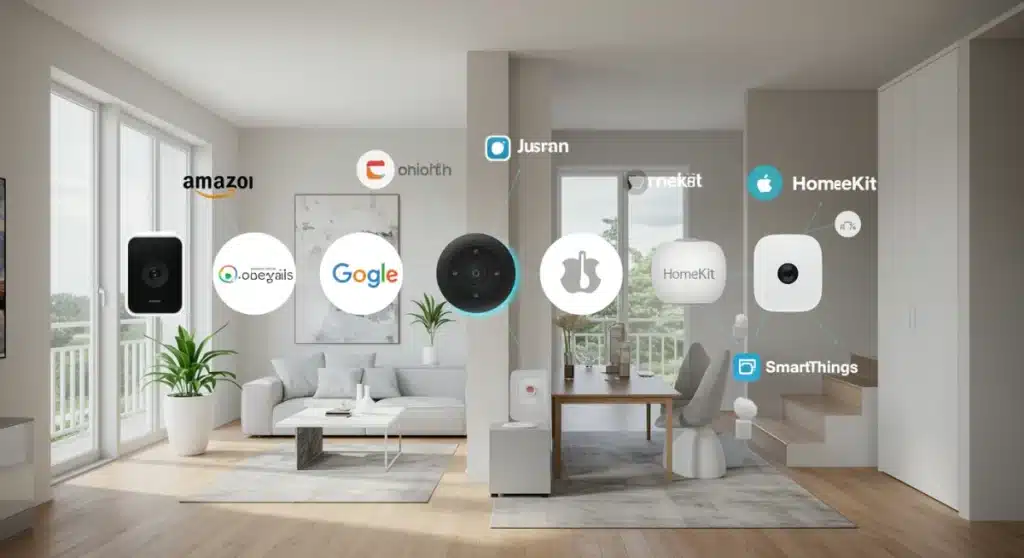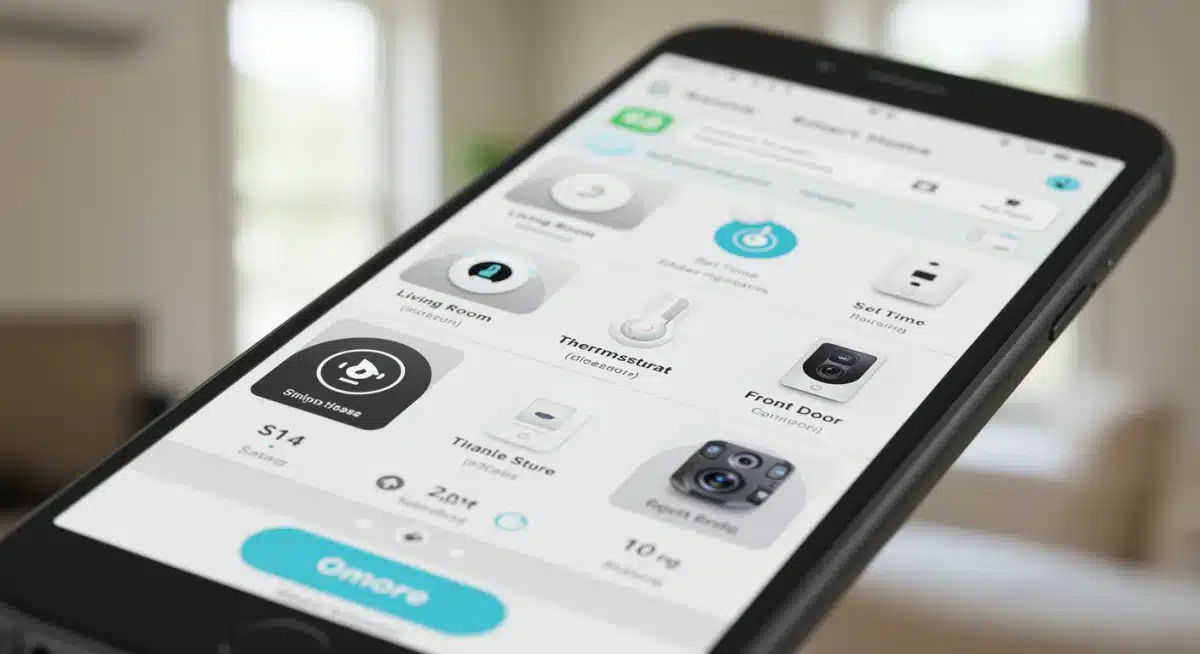Home Automation Platforms: 2025 Review of Top 4 US Systems

As of early 2025, the home automation landscape in the US is rapidly evolving, with four key platforms—Amazon Alexa, Google Home, Apple HomeKit, and Samsung SmartThings—dominating the market, each offering distinct advantages in integration, user interface, and device compatibility.
The landscape of smart living is continuously evolving, and understanding the dominant forces is crucial. In 2025, the competition among home automation platforms in the US is more intense than ever, with major tech giants vying for control of your connected home. This review provides a timely, factual analysis of the top four systems currently shaping the market.
Current Dynamics of the US Smart Home Market
As of Q1 2025, the United States smart home market continues its robust growth, driven by increasing consumer demand for convenience, energy efficiency, and enhanced security. Recent data indicates a significant uptick in multi-platform households, suggesting that users are often integrating devices from various ecosystems rather than committing to a single brand exclusively.
This evolving user behavior is prompting platform developers to prioritize broader compatibility and seamless integration, moving away from closed ecosystems. The emphasis is now on creating more flexible and interoperable smart home solutions that cater to diverse consumer needs and existing device inventories.
Key Market Trends Shaping 2025
- Interoperability Focus: Matter protocol adoption is accelerating, easing cross-platform device compatibility.
- AI Integration: Advanced AI for predictive automation and personalized user experiences is becoming standard.
- Energy Management: Smart home systems are increasingly offering robust features for monitoring and optimizing energy consumption.
- Enhanced Security: Biometric authentication and advanced threat detection are integrated into more smart home security solutions.
Amazon Alexa: The Ubiquitous Voice Assistant
Amazon Alexa remains a dominant force in the US home automation sector, primarily due to its widespread device penetration and highly intuitive voice control capabilities. The Alexa ecosystem, as of early 2025, boasts an unparalleled range of compatible devices, from smart speakers and displays to a vast array of third-party smart home gadgets. Its strength lies in its accessibility and the continuous integration of new features, including more sophisticated routines and AI-driven predictive actions.
Recent updates have focused on refining Alexa’s understanding of complex commands and improving its ability to manage multiple simultaneous requests. This has significantly enhanced the user experience, making daily interactions with smart home devices more fluid and natural. Furthermore, Amazon’s aggressive strategy in expanding its device portfolio ensures Alexa’s presence in nearly every aspect of smart living.
Alexa’s Strengths and Recent Enhancements
- Vast Device Compatibility: Supports thousands of smart home devices across various categories.
- Advanced Voice Control: Improved natural language processing for more intuitive commands.
- Routine Automation: Highly customizable routines that can trigger multiple actions based on schedules or events.
- New AI Capabilities: Predictive suggestions and personalized automation based on user habits.
Google Home: Intelligent Automation at Your Fingertips
Google Home continues to be a formidable competitor, leveraging Google’s prowess in AI and search to offer a highly intelligent and integrated smart home experience. As of 2025, Google Home excels in its ability to understand context and provide proactive assistance, often anticipating user needs before they are explicitly stated. Its seamless integration with Google Assistant across Android devices and other Google services makes it a natural choice for users deeply embedded in the Google ecosystem.
The platform’s strength also lies in its robust device control and its ability to manage complex scenarios through its ‘Routines’ feature, which has seen significant enhancements in flexibility and trigger options. Google’s ongoing commitment to the Matter standard further positions it as a leader in cross-platform compatibility, ensuring a wider range of device choices for its users.

Google Home’s Edge in Smart Integration
Google Home’s deep integration with other Google services, such as Calendar, Maps, and Search, provides a level of contextual awareness that few competitors can match. This allows for highly personalized automation, such as adjusting home climate based on traffic conditions for your commute, or turning off lights when your phone indicates you’ve left the immediate vicinity of your home. The platform’s ability to learn and adapt to user behavior continuously improves the smart home experience.
Its device support is extensive, covering everything from smart lighting and thermostats to security cameras and entertainment systems. The user interface, accessible via the Google Home app, is designed for ease of use, providing a centralized dashboard for managing all connected devices and routines.
Apple HomeKit: Privacy-Centric and Secure Ecosystem
Apple HomeKit, while perhaps not as broadly adopted as Alexa or Google Home, maintains a dedicated user base, particularly among those prioritizing privacy and security. In 2025, HomeKit continues to appeal to Apple device owners with its seamless integration into the iOS and macOS ecosystems. Its emphasis on local processing for many commands, rather than cloud-based, enhances both response times and data privacy, a significant differentiator in the smart home market.
The platform’s stringent certification requirements ensure that all HomeKit-compatible devices meet high standards for security and reliability. This commitment to quality and user data protection resonates strongly with consumers who are increasingly concerned about digital privacy. Recent updates have focused on expanding device categories and improving the Home app’s user interface, making it more intuitive for managing complex smart home setups.
HomeKit’s Distinct Advantages
- Robust Security: End-to-end encryption and local processing for enhanced data privacy.
- Seamless Apple Integration: Works effortlessly with iPhones, iPads, Apple Watches, and Macs.
- Strict Device Certification: Ensures high quality and security standards for compatible devices.
- Simplified Home App: An intuitive interface for managing all HomeKit accessories and automations.
Samsung SmartThings: The Versatile Hub for Connectivity
Samsung SmartThings stands out as a highly versatile and open platform, known for its ability to connect a vast array of devices from various manufacturers. As of 2025, SmartThings continues to be a favorite among users who desire maximum flexibility and control over their smart home ecosystem without being tied to a single brand. Its strength lies in its hub-centric approach, which acts as a central brain for connecting Zigbee, Z-Wave, Wi-Fi, and Matter-compatible devices.
The platform’s robust developer community and open API have fostered a rich ecosystem of custom automations and integrations, allowing users to create highly personalized smart home experiences. Recent developments have focused on improving the stability and speed of the SmartThings hub, as well as enhancing the mobile application for a more streamlined user experience. Its deep integration with Samsung’s extensive product line, from TVs to appliances, also provides a compelling advantage for existing Samsung users.
SmartThings’ Interoperability and Customization
SmartThings excels in offering broad device compatibility, making it an excellent choice for users with a mix of smart home products from different brands. This platform allows for intricate automation scenarios, enabling devices to communicate and react to each other in sophisticated ways. For example, a motion sensor might trigger lights to come on, while simultaneously sending a notification to your phone and adjusting your smart thermostat, all within a single, customized routine.
The platform also supports advanced scripting through Groovy IDE, catering to more technical users who wish to push the boundaries of home automation. This level of customization ensures that SmartThings can adapt to virtually any smart home requirement, from basic lighting control to complex security and energy management systems.
Comparative Analysis: Choosing Your Ideal Platform
When selecting a home automation platform in 2025, several factors warrant consideration. Each of the top four systems—Amazon Alexa, Google Home, Apple HomeKit, and Samsung SmartThings—offers a unique set of advantages and caters to different user priorities. The choice often boils down to existing device ecosystems, desired level of privacy, and the importance of specific features like voice control or deep customization.
For those prioritizing extensive device compatibility and intuitive voice control, Amazon Alexa remains a strong contender. Google Home appeals to users seeking advanced AI integration and contextual awareness, particularly those already invested in Google’s services. Apple HomeKit is the go-to for iPhone users who place a premium on privacy, security, and seamless integration with their Apple devices. Samsung SmartThings, with its open ecosystem and robust hub, is ideal for tech-savvy individuals who desire maximum flexibility and customizability across a wide range of devices.
Decisive Factors for Platform Selection
- Ecosystem Compatibility: Consider your current devices (phone, smart speakers, etc.) and choose a platform that integrates well.
- Privacy Concerns: Evaluate how each platform handles your data and personal information.
- Device Range: Check if your preferred smart home devices are compatible with the chosen platform.
- User Interface: Assess the ease of use of the app and voice commands.
- Automation Capabilities: Look into the complexity and flexibility of routines and automations.
| Platform | Key Strengths |
|---|---|
| Amazon Alexa | Extensive device compatibility, ubiquitous voice control, vast third-party integrations. |
| Google Home | AI-powered intelligence, contextual awareness, deep integration with Google services. |
| Apple HomeKit | Strong privacy and security features, seamless integration with Apple ecosystem. |
| Samsung SmartThings | High versatility, open ecosystem, extensive device support via hub. |
Frequently Asked Questions About Home Automation Platforms
Apple HomeKit is largely considered the most secure platform due to its stringent device certification, emphasis on local processing, and robust encryption protocols. This design minimizes external data exposure, offering enhanced privacy for users concerned about their personal information.
Amazon Alexa and Samsung SmartThings generally offer the widest device compatibility. Alexa supports thousands of third-party devices, while SmartThings, with its versatile hub, connects a vast array of Zigbee, Z-Wave, Wi-Fi, and Matter-compatible components, making it highly flexible.
Yes, increasingly, platforms can work together, especially with the growing adoption of the Matter protocol. While full, seamless integration across all features may vary, many devices are now designed to be compatible with multiple ecosystems, allowing for more flexible smart home setups.
Google Home’s primary advantage in 2025 lies in its advanced AI and contextual awareness. Leveraging Google’s vast data and search capabilities, it offers proactive assistance and highly personalized automations, often anticipating user needs before explicit commands are given.
While many individual smart devices can connect directly to Wi-Fi, a dedicated smart home hub, like those used by SmartThings, often enhances performance, reliability, and allows for more complex automations by centralizing control and bridging different communication protocols (e.g., Zigbee, Z-Wave).
Looking Ahead: The Future of Home Automation
The trajectory of home automation platforms in the US points towards greater interoperability, enhanced AI capabilities, and an even stronger emphasis on user data privacy. As of now, the Matter protocol is poised to further break down ecosystem barriers, paving the way for a truly unified smart home experience. Consumers can anticipate more personalized and predictive automation, with systems learning and adapting to individual lifestyles with unprecedented accuracy. The ongoing competition among these tech giants will undoubtedly drive innovation, making smart homes more accessible, intelligent, and secure in the years to come.





